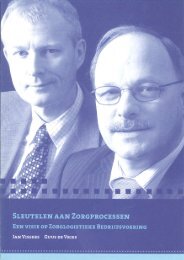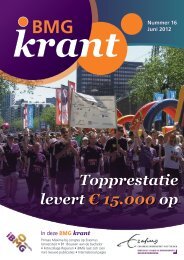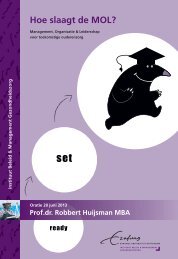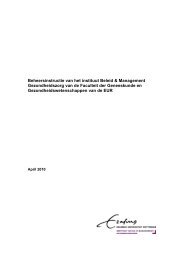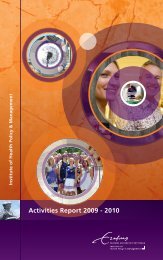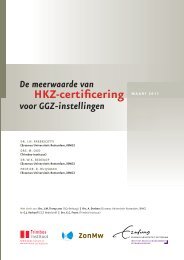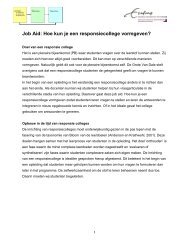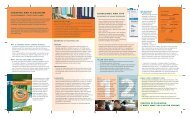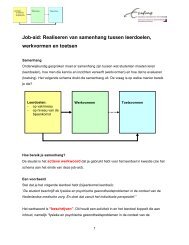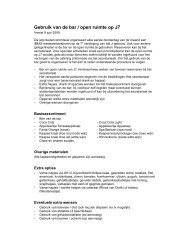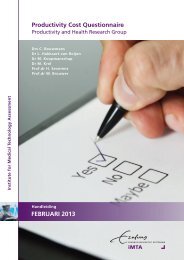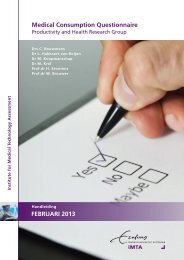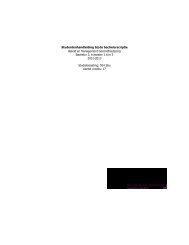90Chapter 6a rule. The health-related quality of life (HRQoL) of patients with ARM however, isa subject of concern. 10-12 Despite the many advances in medical therapy andalthough recently better survival rates have been published, 13-15 the mortalityrate in CDH still remains around 40%. In the survivors, a variety of symptomshas been reported especially in the first years of life, 16,17 but eventually most CDHsurvivors enjoy healthy lives. 18This study aims to explore the caregiving tasks done by these patients' parents.Note that the costs that fall to the caregivers (i.e., transportation costs incurredin visiting and costs associated with production losses) were already taken intoaccount in the economic evaluations of treating ARM and CDH presented inChapters 2 and 3. 19,20 A second objective is to assess the effects of providinginformal care. To achieve this, there are various options, such as measuringgeneral effects on the caregivers' wellbeing, marital and life satisfaction, orbroadly-defined quality of life, 6,21 burden of informal care, 22-24 or HRQoL. Wechose to measure generic HRQoL, as compared to the general population. HRQoLrefers to the aspects of quality of life that relate specifically to a person's health.There is not yet any conclusive evidence on the effect of caregiving on themultidimensional HRQoL of caregivers for children suffering from congenitalanomalies. A few earlier studies, which relate to other disease areas, suggestedthat performing caregiving tasks indeed has negative consequences for informalcaregivers' HRQoL and that support for informal caregivers is needed. 25-276.2 MATERIALS AND METHODSPatients and their parentsThe study population comprised all children who were born with either ARM orCDH and who had received neonatal surgery in the Sophia Children's Hospital. Weincluded the parents of patients that were between 1 and 11 years of age.Parents whose child had died were excluded. Data were collected by means of apostal questionnaire that covered several aspects of informal caregiving. Twocopies were enclosed for the parent(s) of each patient and, where relevant, bothparents were asked to fill in the questionnaire.As mentioned above, ARM is characterized by relatively high morbidity andrelatively low mortality, whereas for CDH the opposite applies. We used thiscontrast in this study. Generally, caregiving for patients with ARM is expected totake more time and to be more discomforting than that for patients with CDH.Presumably, parents of patients with ARM have to perform heavier and moreskilled care tasks (e.g., performing anal dilatations or dealing with a colostomy)for patients with more physical dysfunction such as long-lasting incontinence. Thisdesign of comparing two different congenital conditions with different types ofcaregiving demands is expected to provide valuable comparisons.
Informal Care for Children Born with Major Congenital Anomalies 91Caregiving and forgone activitiesWe investigated whether or not it was the parents' impression that their childdemanded above-average care and, if so, using an open-ended question, whatactivities were involved. The parents were questioned about the amount of extrahours spent per week on caregiving compared with other children of the sameage. Moreover, we studied whether the parents had to forgo paid work andunpaid activities, expressed as number of hours per week, in order to provideinformal care. These questions were taken from a preliminary version of theHealth and Labor Questionnaire. 28Measuring parents' health-related quality of lifeGeneric HRQoL measures—encompassing physical, mental, and social domains—are common and easy-to-use measures that apply to a wide range of conditionsor populations. 29,30 We aimed at applying an easy-to-use, straightforwardinstrument to measure informal caregivers' HRQoL. The parents were administeredthe EQ-5D questionnaire. In the EQ-5D approach, HRQoL is conceptualized ashaving physical, mental, and social domains. The parents were first asked toclassify their health on the EQ-5D descriptive system. 31 This involved respondersclassifying themselves on five dimensions of health, each with three levels ofdysfunction: mobility, self-care, usual activities, pain/discomfort, andanxiety/depression. This 'descriptive system' generates 243 theoretically possiblehealth states. Building on earlier work in the UK that elicited valuations for asubset of health states from a general population sample, Dolan published a valueset for all the possible health states using modeling techniques. 32 This resulted inan index that assigned a value 1 to normal health and 0 to death. We calculatedthe parents' EQ-5D index scores using this model. These scores were comparedto age- and sex-specific scores elicited in the general population. 33 Differenceswere considered significant if P is less than 0.05.Second, the parents were asked to rate their current health state on the EQ-VAS,a 20 cms vertical rating scale calibrated from 0 (worst imaginable health state) to100 (best imaginable health state). 31 This provided information on their selfassessedHRQoL and the scores were also compared to general populationratings. 33Third, the parents rated their health state on the EQ-VAS on the assumption thatsomeone will take over their informal caregiving activities completely and free ofcharge, so that they will no longer have to spend time on their current caregivingtasks. This hypothetical scenario will hereafter be cited within the text as theCareQol scenario or the CareQol scale.More details on the EQ-5D descriptive system and the EQ-VAS are availablethrough http://www.euroqol.org.
- Page 3:
COST-EFFECTIVENESS OF NEONATAL SURG
- Page 6 and 7:
DOCTORAL COMMITTEEPromotors:Prof.dr
- Page 9 and 10:
PUBLICATIONSChapters 2 to 7 are bas
- Page 11:
6ChapterINFORMAL CARE FOR CHILDREN
- Page 14 and 15:
2Chapter 11.1 BACKGROUND AND MOTIVA
- Page 16 and 17:
4Chapter 1provides a good overview
- Page 18 and 19:
6Chapter 1disability, and death of
- Page 21:
Introduction 9particular equity pri
- Page 25 and 26:
Introduction 1320. Oostenbrink JB,
- Page 27 and 28:
Introduction 1554. Heyman MB, Harma
- Page 29 and 30:
THE COST-EFFECTIVENESS OFTREATMENT
- Page 31:
Cost-Effectiveness of Treatment for
- Page 35 and 36:
Cost-Effectiveness of Treatment for
- Page 37 and 38:
Cost-Effectiveness of Treatment for
- Page 39 and 40:
Cost-Effectiveness of Treatment for
- Page 41 and 42:
Cost-Effectiveness of Treatment for
- Page 43 and 44:
Cost-Effectiveness of Treatment for
- Page 45:
Cost-Effectiveness of Treatment for
- Page 48 and 49:
36Chapter 3ABSTRACTBackground/Purpo
- Page 50 and 51:
38Chapter 33.2 MATERIALS AND METHOD
- Page 52 and 53: 40Chapter 3child's date of birth) a
- Page 54 and 55: 42Chapter 3diaphragm was closed (Ta
- Page 56 and 57: 44Chapter 3Total costs of treatment
- Page 58 and 59: 46Chapter 3Regarding the treatment
- Page 60 and 61: 48Chapter 3REFERENCES1. Stolk EA, P
- Page 62 and 63: 50Chapter 332. Jaillard S, Pierrat
- Page 64 and 65: 52Chapter 4ABSTRACTAims:To examine
- Page 66 and 67: 54Chapter 4Outcome measuresThe pati
- Page 68 and 69: 56Chapter 4Clearly, the symptoms st
- Page 70 and 71: 58Chapter 4The respondents did not
- Page 72 and 73: 60Chapter 4Table 4.4TAIQOL Scores o
- Page 74 and 75: 62Chapter 44.4 DISCUSSIONIn this pa
- Page 76 and 77: 64Chapter 4ACKNOWLEDGMENTSWe are in
- Page 78 and 79: 66Chapter 418. Coons SJ, Rao S, Kei
- Page 80 and 81: 68Chapter 5ABSTRACTObjective:Extrac
- Page 82 and 83: 70Chapter 5treatment. 26,27 Finally
- Page 84 and 85: 72Chapter 5CostsOnly direct costs w
- Page 86 and 87: 74Chapter 5summarized in Table 5.2.
- Page 88 and 89: 76Chapter 5Table 5.3 Direct Medical
- Page 90 and 91: 78Chapter 5Figure 5.3 illustrates o
- Page 92 and 93: 80Chapter 5severely ill newborns—
- Page 94 and 95: 82Chapter 5REFERENCES1. Bartlett RH
- Page 96 and 97: 84Chapter 533. Meinert CL: Extracor
- Page 98 and 99: 86Chapter 568. Hui TT, Danielson PD
- Page 100 and 101: 88Chapter 6ABSTRACTObjective:To inv
- Page 104 and 105: 92Chapter 6Regression analysis of h
- Page 106 and 107: 94Chapter 6that caregiving for thei
- Page 108 and 109: 96Chapter 6Table 6.5 CareQol Compar
- Page 110 and 111: 98Chapter 6children with a disabili
- Page 112 and 113: 100Chapter 6This study was of impor
- Page 114 and 115: 102Chapter 618. Poley MJ, Stolk EA,
- Page 116 and 117: 104Chapter 654. Boman KK, Viksten J
- Page 118 and 119: 106Chapter 7ABSTRACTMortality rates
- Page 120 and 121: 108Chapter 77.2 THE RELEVANCE OF CO
- Page 122 and 123: 110Chapter 7In the early 2000s, our
- Page 124 and 125: 112Chapter 7Table 7.1 Economic Eval
- Page 126 and 127: 114Chapter 7More from a policy pers
- Page 128 and 129: 116Chapter 7also expect that life-s
- Page 130 and 131: 118Chapter 7entirely justified, for
- Page 132 and 133: 120Chapter 723. Sydorak RM, Nijagal
- Page 134 and 135: 122Chapter 765. Glaser AW, Davies K
- Page 137 and 138: GENERAL DISCUSSION:A GUIDED TOURPRO
- Page 139 and 140: General Discussion: A Guided Tour P
- Page 141 and 142: General Discussion: A Guided Tour P
- Page 143 and 144: General Discussion: A Guided Tour P
- Page 145 and 146: General Discussion: A Guided Tour P
- Page 147 and 148: General Discussion: A Guided Tour P
- Page 149 and 150: General Discussion: A Guided Tour P
- Page 151: General Discussion: A Guided Tour P
- Page 154 and 155:
142GlossaryCharge (or: tariff)A pri
- Page 156 and 157:
144Glossaryefficient one. We are th
- Page 159 and 160:
SUMMARY
- Page 161 and 162:
Summary 149mortality. Finally, it i
- Page 163 and 164:
Summary 151neonatal surgery. It is
- Page 165 and 166:
SAMENVATTING
- Page 167 and 168:
Samenvatting 155zoals directe niet-
- Page 169 and 170:
Samenvatting 157Hoofdstuk 6 gaat ve
- Page 171:
Samenvatting 159vereisen, waarvoor
- Page 174 and 175:
162AcknowledgmentsAlthough I am ind
- Page 176:
About the AuthorBorn in De Meern (N




